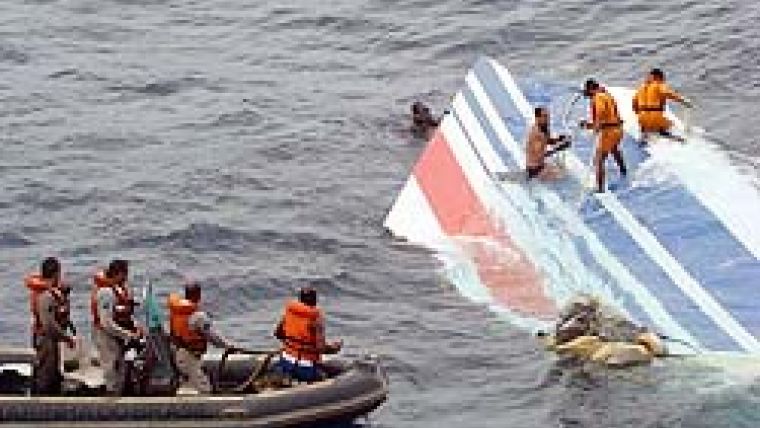Air France Flight AF 447
A Challenge for Search and Recovery Technology
Air France flight 447, a scheduled passenger service from Rio de Janeiro (Brazil) to Paris (France), went missing on 1 June 2009 over the Atlantic Ocean with 228 people onboard. The aircraft took off from Galeão International Airport at 22:03 (UTC) on 31 May 2009 with an expected flight time of 11 hours. Contact was lost 4 hours into the flight. No distress calls were made. The recovery of aircraft parts and the ‘black-box’ recorders will be crucial to the investigation team – these tasks will challenge equipment, techniques and the ingenuity of the teams at sea.
Flight Reporting
View Larger Map
The plane followed its routine flight path, tracking the Brazilian coast north-eastwards and turning to cross the Atlantic at waypoint NATAL (see Figure 2).
The last voice report was at 01:33 close to waypoint INTOL (01°21´39"S, 032°49´53"W), 565km off the Brazilian coast: the aircraft was flying normally at 35,000 feet with a speed of 467 knots. The aircraft left Brazilian radar surveillance at 01:48. Messages from the onboard aircraft communications and reporting system (ACARS) maintenance system were received between 02:10 and 02:14 with five FLR (failure) and 19 WRN (warning) reports, indicating that airspeed sensors were giving inconsistent readings, the autopilot and auto-thrust systems had disengaged and the final message was a cabin pressure (vertical speed) warning at 02:14 from location 3°34´40"N 30°22´28"W.
Weather Conditions
A preliminary assessment of the Meteosat imagery from the time of the incident revealed a cluster of severe thunderstorms with hail and air turbulence in the vicinity of the planned aircraft trajectory, although these were not exceptional.
Investigation
The Bureau of Enquiry and Analysis for Civil Aviation Safety (BEA) will undertake the official investigation. Its role is to determine the circumstances of an event, identify causes and issue safety recommendations – its scope is distinct from any judicial investigation. The recovery of the black-box cockpit voice recorder (CVR) and flight data recorder (FDR) will provide crucial information for the BEA investigation team.
Search
At the time of writing, Brazilian military teams have recovered 50 bodies, as well as scattered debris including a section of tailplane (see Figure 1). The scatter of debris extends over a 50-mile area and two distinct clusters have been reported, suggesting the plane may have broken into two in mid-air. French authorities have despatched five ships: IFREMER research vesselPourquoi Pas?; two tugboats,Fairmount GlacierandFairmount Expedition; naval frigateVentôse; and nuclear submarineEmeraude.Ventôsehas assisted with recovery of floating debris and bodies.Emeraudewill conduct an initial search listening for the black-box pinger. Once this has been located,Pourquoi Pas?shall carry out a side-scan sonar survey and there are plans to then deploy a mini-submarine to carry out a detailed photographic survey leading to recovery operations.
The accident location is 1,000km from the Brazilian coastline and the sea floor is extremely rugged (making side-scan sonar operations troublesome) and around 3,500 metres deep (making it difficult to detect the black-box pinger with a maximum range of 2–3km). Both operations will require a submersible or deep-tow capability for sensor deployments. Subsequent recovery of substantial aircraft parts will be an almost-impossible task and operations will probably be limited to flight recorder recovery and a detailed sonar and photographic survey.
Despite these problems, there is a precedent for location of sea-floor debris and recovery in these conditions. In 1988, the CVR from South Africa Airways flight 295 was found at a depth of 4,900m in the Indian Ocean. The search phases of this operation were surface search and recovery; underwater pinger beacon search; side-scan sonar and underwater photographic surveys; and recovery. It took two months to locate the aircraft wreckage and more than a year to recover the CVR. The FDR was not found.
Black-box Recorders
The aircraft on flight AF 447 was F-GCZP, an Airbus A330-203, which came into service in April 2005. Detailed reconstruction of events leading to the accident relies on the information recorded by the black boxes. Two black-box recorders are located in the after section of the fuselage (the most crash-survivable part of the aircraft). The FDR monitors altitude, airspeed and heading, and some units record up to 1,000 separate parameters. The CVR records radio transmissions and voice and engine noise in the cockpit. Each recorder is fitted with an underwater locator beacon (ULB). The ULB pinger has an acoustic frequency of 37.5kHz, transmitting initially with 1,060 dynes/cm2, and has a battery life of at least 30 days. Maximum detection range is 2–3km.
The Challenges
The most urgent task after recovery of floating debris is to locate the black-box pinger. Once this location is known, a more systematic programme of operations can be planned and this can be undertaken in discrete phases, allowing a thorough analysis of the results of each stage.
A multi-beam echosounder (MBES) bathymetry survey will provide a good general idea of sea-floor depths and topography, although given the resolution of surface-deployed MBES it is unlikely to positively detect aircraft debris. A deep-towed side-scan sonar survey should enable the compilation of more detailed sea-floor imagery and identify larger sections of aircraft wreckage.
Further survey operations could be planned from an AUV or submersible to get the highest resolution dimensional measurements and acoustic imagery. This might be followed by a photographic mission to discover more about the condition of the aircraft.
Interventions to recover the black-box recorders and then to consider other significant items of debris will be major operations, involving manyvessels and large teams over an extended period.

Value staying current with hydrography?
Stay on the map with our expertly curated newsletters.
We provide educational insights, industry updates, and inspiring stories from the world of hydrography to help you learn, grow, and navigate your field with confidence. Don't miss out - subscribe today and ensure you're always informed, educated, and inspired by the latest in hydrographic technology and research.
Choose your newsletter(s)
























